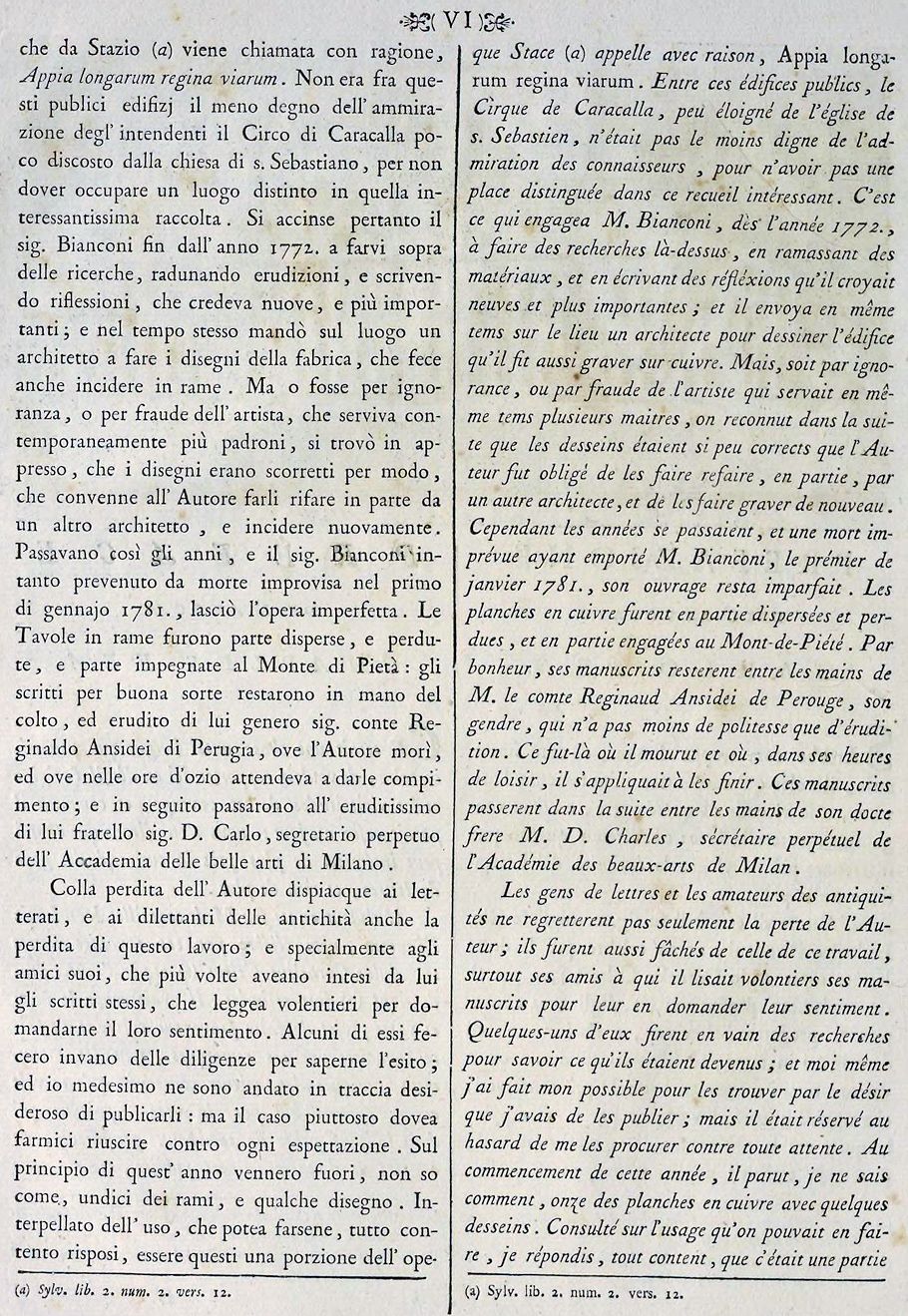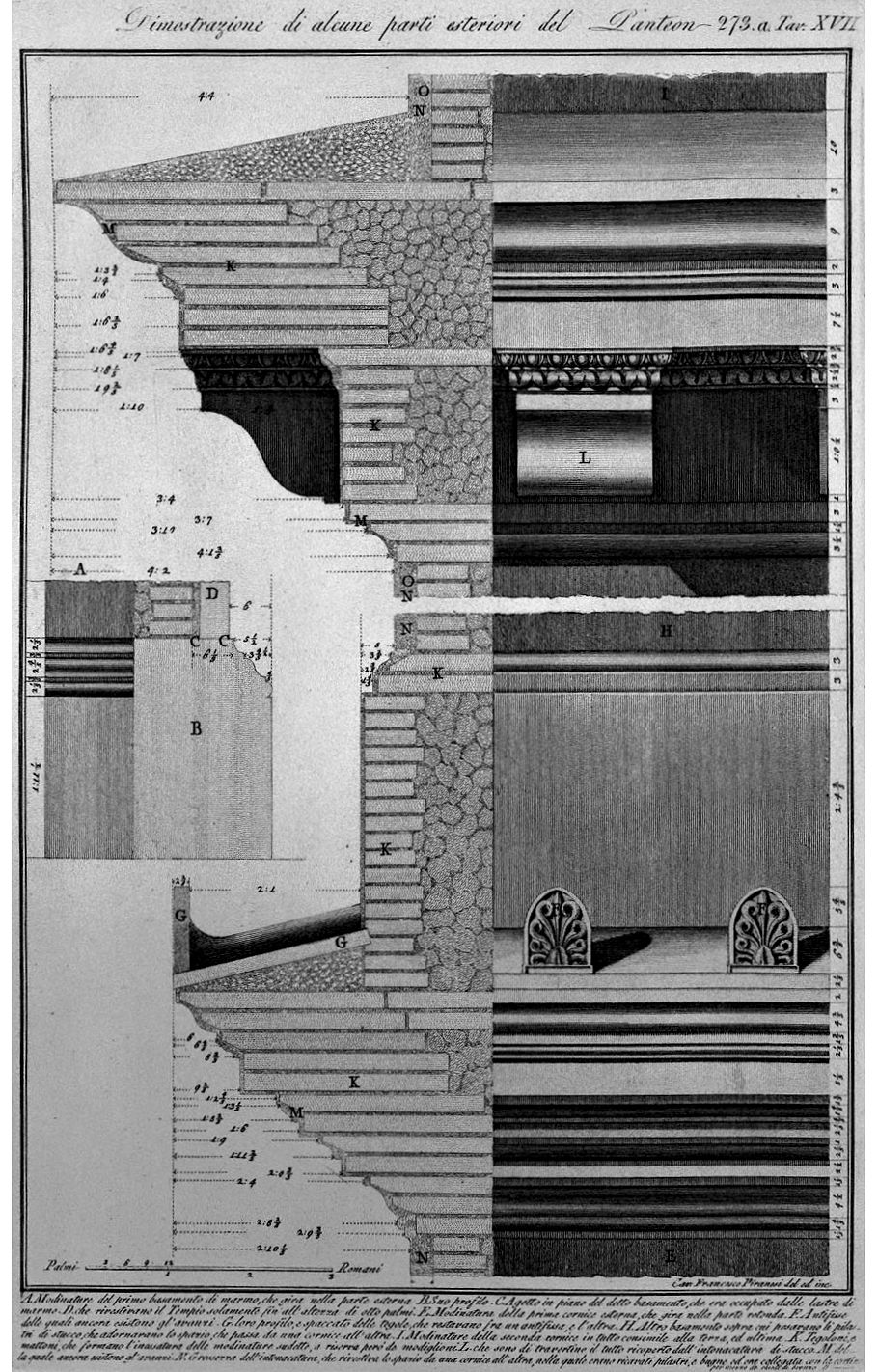14 June 1778 Sunday
"Find out who's Bianconi's spies these days. I bet they're still the same; he's so cheap," he was thinking to himself. "And what an idiot! He's still insisting symmetry must prevail. . . What did he say? "No, no! The walls are not straight because they built it wrong. They probably didn't have time to fixe them, but, of course, it was all supposed to be symmetrical!" What a fool."
1789
Descrizione dei circhi, particolarmente di quello di Caracalla e dei giochi in esso celebrati
Description of circuses, particularly that of Caracalla and the divine games celebrated in it

He had conceived the beautiful and very vast project of giving engraved in copper, and illustrating with his observations, all the most preserved ancient monuments, which can still be seen today along the Via Appia, which was the most decorated with grandiose sepulchres, times, and of other public buildings, such as that, which Stazio is rightly called, Appia is the queen of long roads. Among these public buildings, not the least worthy of the admiration of the connoisseurs was the Circus of Caracalla, not far from the church of S. Sebastiano, so as not to have to occupy a distinct place in that very interesting collection. Therefore, Mr. Bianconi from the year 1772 to carry out research on it, gathering eruditions, and writing reflections, which he believed to be new and more important; and at the same time he sent an architect to the place to make the drawings of the building, which he also had engraved in copper. But whether it was through ignorance or fraud by the artist, who served several masters at the same time, it was later found that the drawings were incorrect in such a way that it behooved the author to have them redone in part by another architect, and to engrave again. Thus the years passed, and in the meantime Mr. Bianconi, prevented by sudden death on January 1, 1781, left the work imperfect. The copper plates were partly dispersed and lost, and partly committed to the Monte di Pietŕ: the writings luckily remained in the hands of his cultured and erudite son-in-law, Mr. count Reginaldo Ansidei of Perugia, where the Author died, and where in his hours of idleness he attended to completing it; and afterwards they passed to his very learned brother, Mr. D. Carlo, perpetual secretary of the Academy of Fine Arts in Milan.
With the loss of the Author, the loss of this work also saddened the men of letters and the amateurs of antiquities; and especially to his friends, who had repeatedly heard from him the writings themselves, which he read willingly to ask for their feelings. Some of them made diligence in vain to find out the outcome; and I myself went in search of them eager to publish them: but chance rather had to make me succeed against all expectations. At the beginning of this year, I don't know how, eleven of the branches and some drawings came out. When asked what use he could make of it, I replied happily that it was a portion of the work that had been wanted for so long and was believed lost: it would be an excellent thing to print it, and that I would be happy to take charge of it.
32 y.o. Francesco Piranesi 1 August 1790
Raccolta de'Tempj antichi, Vol. II.

Demonstration of some external parts of the Pantheon
A. Mouldings of the first base, which rotates on the outside. B. Your profile. C. Plane height of the said base, which was occupied by the marble slabs. D. which covered the Temple only up to the height of eight palms. E. Moulding of the first external frame, which rotates in the round part. F. Antifixes of which the remains still exist. G. their profile, and cutaway view of the tiles, which remained between one antifix and the other. H. Another base on which the stucco pillars rested, which adorned the space, which passes from one frame to another. I. Mouldings of the second frame in all similar to the third and last. K. Tiles, and bricks, which form the anchoring of the aforementioned moldings, however in reserve for the modillions. L. which are in travertine all covered with stucco plastering. M. of which the remains still exist. N. Thickness of the plastering, which covered the space from one frame to the other, in which pillars and ashlars were obtained and was connected to the curtain by means of bronze nails
Cav. Francesco Piranesi drawn and engraved
14 June 1812 Sunday

JL and wife, S Hutchinson and son R, C and T Longstreth came from Meeting to dine with us. A very pleasant day. Temperature not observed.
14 June 2023 Wednesday
[unedited]
I'm making a list, probably for a few days, till all the racing thoughts are written down.
There's not much now that needs proving (anymore) regarding Piranesi's final project. Bianconi, via Fea, clearly attributes the unsigned Circus of Caracalla site plan to Piranesi, and both Bianconi and Piranesi worked on the Circus of Caracalla at the same time, albeit adversarially. Ironically, Bianconi's work is ultimately published, repeatedly assuring everyone of it's correctness, while the Piranesis' work, which is indeed correct and includes an actual discovery, remained near completely unnoticed for 244 years.
An exhibit of Piranesi rarities. e.g., giving provenance to the 'virgin' Ichnographia Campus Martius prints at Dresden.
Francesco was very popular in Rome. Fea, himself, greatly admired the whole thing, wanted to be just like it. It's actually relevant that Francesco, early on, got out of having to become a priest, yet still made all those potentially life-altering connections, whereas Fea, ultimately, had to become a priest to make all those life-altering connections.
Reflections are by nature inversions.
|